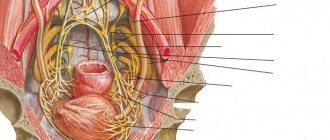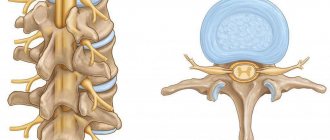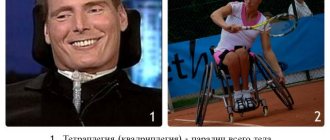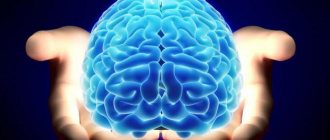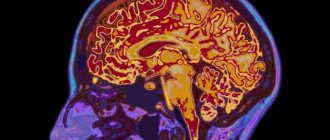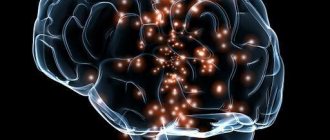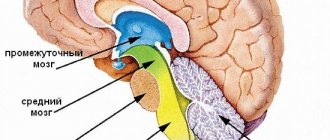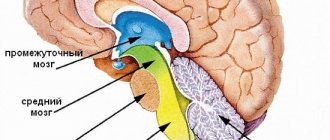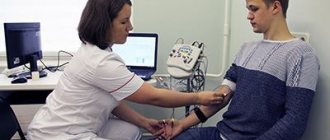From the nerve cells located in the brain and spinal cord, processes extend, which are nerve fibers going to the periphery. Nerve fibers are collected in bundles of different thicknesses. This collection of nerve fibers is called a nerve.
Nerves communicate between the central nervous system and individual organs of our body. Excitation goes along the nerves either from the central nervous system to the working organ, or from different parts of our body to the central nervous system.
Nerves are divided into two groups depending on the direction in which they conduct excitation.
Rice. Scheme of propagation of excitation during nerve irritation
One group of nerves conducts excitation from the central nervous system to the working organs. They are called efferent (centrifugal, or motor) nerves. Another group conducts stimulation from different parts of our body and from different organs to the central nervous system. Unlike the previous group of nerves, they are called afferent (centripetal, or sensory) nerves. Both types of nerve fibers often run in the same trunk, so most nerves are mixed.
NERVE STRUCTURE
The nervous system is made up of nerve cells called neurons. A neuron consists of a nerve cell body and its processes. There are two types of processes: a) short, branched processes - dendrites, and b) a very long process that stretches from the central nervous system to the working organ - axon, which is involved in the formation of nerves.
Finally, there are also special formations at the endings of nerves - the so-called terminal devices, with the help of which the nerve fiber is connected to a muscle, gland or other organs, or receptors - the endings of centripetal nerves that perceive irritation.
Short processes - dendrites - communicate between individual nerve cells and hardly extend beyond the central nervous system.
The axon stretches from the brain or spinal cord to the working organ. The nerves that we find in the body consist of axons that carry excitation to the central nervous system or, conversely, from the central nervous system.
The normal course of metabolism in all processes of a nerve cell is associated with its integrity. This can be verified by cutting the nerve fiber and thereby disrupting its connection with the cell body. The activity of such a fiber is disrupted, and the part that is cut off from the cell dies. Completely different phenomena are observed in that part of the fiber that remains connected to the cell body. This part continues to live, functions normally, metabolism is not impaired. Moreover, such a segment grows and after some time it can reach the muscle, which will restore the integrity of the nerve. This explains the sometimes observed restoration of movements of a paralyzed limb after a certain period of time, if the paralysis was caused by nerve damage.
This feature is also used by surgeons who often stitch together nerves in order to restore the activity of a paralyzed organ.
The nerve cell is excited under the influence of those waves of excitation that come from the periphery along the centripetal nerves. However, many nerve cells can be excited even without receiving impulses from the receptors. In these cells, excitation can occur under the influence of humoral influences. An example is the activity of the thermal center, the functions of which are influenced by blood temperature, etc.
Neuron structure
Neurons, or neurocytes, of different parts of the nervous system differ significantly from each other in functional significance and morphological features.
Depending on their function, neurons are divided into:
- receptor (sensitive, afferent) - generate a nerve impulse under the influence of various influences from the external or internal environment of the body;
- intercalary (associative) - carry out various connections between neurons;
- effector (efferent, motor) - transmit excitation to the tissues of the working organs, prompting them to action.
A characteristic feature of all mature neurons is the presence of processes.
These processes ensure the conduction of a nerve impulse through the human body from one part to another, sometimes very distant, and therefore their length varies widely - from several micrometers to 1-1.5 m.
Based on their functional significance, neuronal processes are divided into two types. Some perform the function of removing nerve impulses, usually from the bodies of neurons, and are called axons or neurites.
The neurite ends with the terminal apparatus or on another neuron, or on the tissues of the working organ, muscles, glands.
The second type of nerve cell extensions is called dendrites. In most cases, they are highly branched, which determines their name. Dendrites conduct impulses to the neuron body.
Based on the number of processes, neurons are divided into three groups:
- unipolar - cells with one process;
- bipolar - cells with two processes;
- multipolar - cells with three or more processes.
Multipolar cells are most common in mammals and humans.
Of the many processes of such a neuron, one is represented by a neurite, while all the others are dendrites.
Bipolar cells have two processes - a neurite and a dendrite. True bipolar cells are rare in the human body. These include some of the cells of the retina, the spiral ganglion of the inner ear and some others. However, based on the essence of their structure, a large group of afferent, so-called pseudounipolar neurons of the cranial and spinal nerve ganglia should be classified as bipolar cells.
They are called pseudounipolar because the neurite and dendrite of these cells begin with a common outgrowth of the body, creating the impression of a single process, followed by a T-shaped division.
There are no true unipolar cells, that is, cells with one process - a neurite, in the human body.
The vast majority of human neurons contain one nucleus located in the center, less often - eccentrically.
Binuclear neurons, and especially multinucleated ones, are extremely rare, for example: neurons in the prostate gland and cervix. The shape of the neuron nuclei is round. In accordance with the high metabolic activity, the chromatin in their nuclei is dispersed. The nucleus has 1, and sometimes 2 and 3 large nucleoli.
In accordance with the high specificity of the functional activity of neurons, they have a specialized plasmalemma, their cytoplasm is rich in organelles.
The cytoplasm has a well-developed endoplasmic reticulum, ribosomes, mitochondria, Golgi complex, lysosomes, neurotubules and neurofilaments.
The plasmalemma of neurons, in addition to the function typical of the cytolemma of any cell, is characterized by the ability to conduct excitation. The essence of this process comes down to the rapid movement of local depolarization of the plasmalemma along its dendrites to the perikaryon and axon.
The abundance of granular endoplasmic reticulum in neurocytes corresponds to a high level of synthetic processes in the cytoplasm and, in particular, the synthesis of proteins necessary to maintain the mass of their perikarya and processes.
Axons that do not have protein-synthesizing organelles are characterized by a constant flow of cytoplasm from the perikarya to the terminals at a speed of 1-3 mm per day. This is a slow current carrying proteins, in particular enzymes necessary for the synthesis of mediators in axon terminals.
In addition, there is a fast current (5-10 mm per hour) transporting mainly components necessary for synaptic function. In addition to the flow of substances from the perikaryon to the terminals of axons and dendrites, a reverse (retrograde) current is also observed, through which a number of cytoplasmic components return from the terminals to the cell body.
The transport of substances along the processes of neurocytes involves the endoplasmic reticulum, membrane-bound vesicles and granules, microtubules and the actinomyosin cytoskeletal system.
The Golgi complex in nerve cells is defined as a cluster of rings, twisted threads, and grains of various shapes.
The cell center is often located between the nucleus and dendrites. Mitochondria are located both in the body of the neuron and in all processes. The cytoplasm of neurocytes in the terminal apparatus of processes, in particular in the area of synapses, is especially rich in mitochondria.
Neurofibrils
When nervous tissue is impregnated with silver, neurofibrils are revealed in the cytoplasm of neurons, forming a dense network in the perikaryon of the cell and oriented in parallel within the dendrites and axons, including their finest terminal branches.
Using electron microscopy, it was established that neurofibrils correspond to bundles of neurofilaments with a diameter of 6-10 nm and neurotubules (neurotubes) with a diameter of 20-30 nm, located in the perikaryon and dendrites between chromatophilic clumps and oriented parallel to the axon.
Secretory neurons
The ability to synthesize and secrete biologically active substances, in particular mediators, is characteristic of all neurocytes.
However, there are neurocytes specialized primarily to perform this function - secretory neurons, for example, cells of the neurosecretory nuclei of the hypothalamic region of the brain. Secretory neurons have a number of specific morphological characteristics:
- secretory neurons are large neurons;
- in the cytoplasm of neurons and in axons there are secretion granules of varying sizes - neurosecretion, containing protein, and in some cases lipids and polysaccharides;
- many secretory neurons have nuclei of irregular shape, which indicates their high functional activity.
"Centripetal nerves" in books
30. Apartment and nerves The next morning Alyosha went to Mrs. Tractenberg. She called someone and told Alyosha: “I spoke with my friends, brothers Isaac and David Herschel.” They will receive you, they have an office on 70th Street. Your position in their eyes is still very
Only nerves Joseph Brodsky was a man with a great talent for friendship. In relation to those he loved, his attention, caring and generosity knew no bounds. Especially if someone was sick or in a difficult situation. About his kindred concern for Stephen
NERVES Two soldiers are slaughtering a pig. The pig squeals so much that it is impossible to move it. I come closer. One soldier is sitting on a pig. The hand of another, armed with a knife, deftly rips open the belly. White fat of immense thickness spreads out on both sides. The squeal is such that at the time
69. Nerves, nerves, nerves... While studying at a military school, despite the initially stable, friendly and trustingly warm relationships between the guys within the educational units, sooner or later, but inevitably and invariably, a disgusting attack occurred
Gender: centrifugal and centripetal forces Nobility With the death of Nikita Demidov, his long-isolated sons move away from each other even more rapidly, diverge even further. And yet not so far as to cut off all family ties. There are still things to do in
My nerves couldn't stand it. Once I was testing the plane. His wings fell off in the air, and I jumped out with a parachute. I am convinced that the people looking at me from the ground were more worried than I was. I was too busy. Admiral Moffett, for example, the one who subsequently crashed
NERVES Today I imagined, As if the one who is dear to me had died... Oh, where does such strength come from In the midnight sorrowful Duma? I couldn’t lie in bed, I couldn’t sleep anyway. Bitter tears boiled on the fire of melancholy - Evil sickness... The night devils mocked... No from them
Nerves Dear Archangel Raphael, please calm and heal my nerves. Help me completely restore the normal functioning of my nervous system. Surround me with your healing green light, which can only saturate my nerves with goodness.
Nerves The main nerve in the knee area is the popliteal nerve, which is located on the back of the knee joint. It is a component of the sciatic nerve, passes through the lower leg and foot and provides sensitivity and movement of data
I. Centripetal and centrifugal eras In recent years, Russian philistinism, i.e. the true philistinism, the social class, the one on which the reflection of the serf era still fell, undoubtedly became Europeanized. The events of revolution and counter-revolution shook the stagnant way of life,
Nerves Nerves, everything is just nerves. Forgive me and understand. Yes, honey, you are not the first in this flow of love. Yes, honey, would you like some tea? I'll brew some fresh. Alone I meet the sleepless dawn. No, honey, I'm not crying, just a speck, that's it. I mean something in your life, Or maybe -
Concept and structure of the reflex arc
A reflex is a universal response of the body to irritation. The unconditioned reflex is transmitted hereditarily and is the same for any person. Conditional is one that is acquired during life. Each person can have his own conditioned reflex.
Afferent and efferent neurons are the main components of the reflex arc.
At its core, a reflex arc is a path that overcomes a nerve impulse to a working organ or muscle. There are three main components of the arc:
- analyzer, or afferent, part;
- central, or contact, part;
- executive, or efferent, part.
According to modern concepts, there are not three, but five parts of the reflex arc. It begins with a receptor - the end of a sensitive neuron. In addition to the receptor, the arc includes the following elements:
- sensitive, or afferent, neuron;
- interneuron;
- motor, or efferent, neuron;
- the organ that responds to stimulation is the effector.
That is, for a reflex arc to form, there must be at least three nerve cells. An exception is the tendon reflexes, which contain only two cells - sensory and motor.
Neurons according to their structure are:
a Bipolar neurons
These neurons have one process (dendrite) leading into the cell body, and an axon leading from it. This type of neuron is mainly found in the retina of the eye. b Unipolar neurons
Unipolar neurons (sometimes called pseudo-unipolar) are initially bipolar, but during development their two processes merge into one. They are found in ganglia, primarily in the peripheral nervous system, along the spinal cord.
c Multipolar neurons
This is the most common type of neuron. They have several (three or more) processes (axons and dendrites) emanating from the cell body and are found throughout the central nervous system. Although most of them have one axon and several dendrites, there are some that have only one dendrites.
d Intermediate (intercalary) neurons
Intermediate neurons, or association neurons, are the line of communication between sensory and motor neurons. Intermediate neurons are found in the central nervous system. They are multipolar and usually have short processes.
| Neuron | Structure | Function |
| Centripetal (sensory neurons) | The cell body is located in the PNS. A short axon leading to the CNS. Long dendrites (branched processes) are located in the PNS. | Transmits signals to the central nervous system from throughout the body |
| Centrifugal (motor neurons) | The cell body is located in the CNS Long axon leading to the PNS Short dendrites (branched processes) are located in the CNS | Sends signals from the central nervous system to the body |
| Intermediate neurons | Long or short axon located in the CNS Short dendrites (branched processes) are located in the CNS | Transmits impulses between centripetal and centrifugal neurons |
Conditioned and unconditioned reflexes
Reflex
- This is the body’s response to irritation of receptors, carried out by the nervous system.
The concept of “reflex” was introduced by Sechenov
; he believed that “reflexes form the basis of the nervous activity of humans and animals.”
Pavlov
divided reflexes into conditioned and unconditioned.
Reflex arc
- this is the path along which the nerve impulse passes during the implementation of the reflex.
Composition of the reflex arc: 1) Receptor
- a sensitive formation capable of responding to a certain type of stimulus;
converts irritation into a nerve impulse. 2) The sensory neuron
sends a nerve impulse to the central nervous system (spinal cord or brain), located in the dorsal root of the spinal cord.
| unconditioned reflex | conditioned reflex |
| 3) Interneuron | 3) such and such center of cortex cerebral hemispheres 4) cerebral hemispheres |
4/6) Executive (motor) neuron
sends a nerve impulse to the working organ, located in the anterior root of the spinal cord.
5/7) Working (executive) organ
– muscle (contracts), gland (secretes), etc.
Comparison of conditioned and unconditioned reflexes
| unconditional | conditional |
| present from birth | acquired during life |
| do not change or disappear during life | may change or disappear during life |
| identical in all organisms of the same species | Each organism has its own, individual |
| adapt the body to constant conditions | adapt the body to changing conditions |
| reflex arc passes through the spinal cord or brain stem | temporary connection is formed in the cerebral cortex |
| Examples | |
| salivation when lemon enters mouth | salivation at the sight of lemon |
| newborn sucking reflex | 6 month old baby's reaction to a bottle of milk |
| sneezing, coughing, pulling your hand away from the hot kettle | reaction of a cat/dog to a name |
Development of a conditioned reflex
Conditional (indifferent)
the stimulus must precede
the unconditioned one
(causing an unconditioned reflex). For example: a lamp is lit, after 10 seconds the dog is given meat.
Inhibition of conditioned reflexes
Conditional (non-reinforcement):
the lamp lights up, but the dog is not given meat. Gradually, salivation when the lamp is turned on stops (the conditioned reflex fades).
Unconditional:
During the action of a conditioned stimulus, a powerful unconditioned stimulus arises. For example, when the lamp is turned on, the bell rings loudly. No saliva is produced.
You can also read
DETAILED SUMMARY: Reflex, reflex arc, conditioned and unconditioned reflexes, Development and inhibition of conditioned reflexes
ASSIGNMENTS OF PART 2 OF THE USE ON THIS TOPIC
Part 1 tasks
Choose one, the most correct option. The centers of conditioned reflexes, in contrast to unconditioned ones, are located in humans in
1) cerebral cortex 2) medulla oblongata 3) cerebellum 4) midbrain
Answer
1
Choose one, the most correct option. Reflexes that cannot be strengthened or inhibited at the will of a person are carried out through the nervous system
1) central 2) vegetative 3) somatic 4) peripheral
Answer
2
Choose one, the most correct option. Salivation in a person at the sight of a lemon is a reflex
1) conditional 2) unconditional 3) protective 4) indicative
Answer
1
Choose one, the most correct option. What are the features of spinal reflexes in humans and mammals?
1) are acquired during life 2) are inherited 3) are different in different individuals 4) allow the organism to survive in changing environmental conditions
Answer
2
Choose one, the most correct option. Nerve impulses are transmitted to the brain through neurons
1) motor 2) intercalary 3) sensitive 4) executive
Answer
3
Choose one, the most correct option. The extinction of a conditioned reflex when it is not reinforced by an unconditioned stimulus is
1) unconditional inhibition 2) conditioned inhibition 3) rational action 4) conscious action
Answer
2
Choose one, the most correct option. A system of neurons that perceive stimuli, conduct nerve impulses and process information is called
1) nerve fiber 2) central nervous system 3) nerve 4) analyzer
Answer
4
Choose one, the most correct option. Conditioned reflexes of humans and animals provide
1) adaptation of the organism to constant environmental conditions 2) adaptation of the organism to the changing external world 3) development by the organism of new motor skills 4) discrimination by animals of the trainer’s commands
Answer
2
Choose one, the most correct option. Sensory neurons in the three-neuron reflex arc are connected to
1) processes of interneurons 2) bodies of interneurons 3) motor neurons 4) executive neurons
Answer
1
Choose one, the most correct option. A baby's reaction to a bottle of milk is a reflex that
1) inherited 2) formed without the participation of the cerebral cortex 3) acquired during life 4) maintained throughout life
Answer
3
Choose one, the most correct option. Conditioned (internal) inhibition
1) depends on the type of higher nervous activity 2) appears when a stronger stimulus occurs 3) causes the formation of unconditioned reflexes 4) occurs when the conditioned reflex fades
Answer
4
Choose one, the most correct option. The basis of nervous activity in humans and animals is
1) thinking 2) instinct 3) excitement 4) reflex
Answer
4
Choose one, the most correct option. When developing a conditioned reflex, the conditioned stimulus must
1) act 2 hours after the unconditional 2) follow immediately after the unconditional 3) precede the unconditional 4) gradually weaken
Answer
3
Choose one, the most correct option. Nerve impulses from receptors to the central nervous system are carried out
1) sensory neurons 2) motor neurons 3) sensory and motor neurons 4) intercalary and motor neurons
Answer
1
ARC STRUCTURE Choose three correct answers out of six and write down the numbers under which they are indicated. Receptors are nerve endings in the human body that
1) perceive information from the external environment 2) perceive impulses from the internal environment 3) perceive excitation transmitted to them via motor neurons 4) are located in the executive organ 5) convert perceived irritations into nerve impulses 6) implement the body’s response to irritation from the external and internal environment
Answer
125
Choose three options. In the human nervous system, interneurons transmit nerve impulses
1) from the motor neuron to the brain 2) from the working organ to the spinal cord 3) from the spinal cord to the brain 4) from sensory neurons to working organs 5) from sensory neurons to motor neurons 6) from the brain to motor neurons
Answer
356
Choose three correct answers out of six and write down the numbers under which they are indicated. What features do interneurons have in the human somatic nervous system?
1) carry out communication between sensory and executive neurons 2) are part of the dorsal roots of the spinal cord 3) are part of the anterior roots of the spinal cord 4) form the bulk of the gray matter of the spinal cord 5) carry out the transmission of nerve impulses to the internal organs 6) carry out the transmission of nerve impulses impulses to motor neurons
Answer
146
Establish a correspondence between the functions and types of neurons: 1) sensitive, 2) intercalary, 3) motor. Write the numbers 1, 2, 3 in the order corresponding to the letters.
A) transmission of nerve impulses from the sense organs to the brain B) transmission of nerve impulses from internal organs to the brain C) transmission of nerve impulses to muscles D) transmission of nerve impulses to glands E) transmission of nerve impulses from one neuron to another
Answer
11332
Analyze the “Neurons” table. For each cell indicated by a letter, select the appropriate term from the list provided.
1) centripetal 2) motor 3) meninges 4) gray matter of the spinal cord 5) white matter of the spinal cord 6) transmission of nerve impulses from receptors to the central nervous system 7) transmission of nerve impulses from the central nervous system to the working organ transmission of nerve impulses to internal organs
transmission of nerve impulses to internal organs
Answer
246
Select three correctly labeled captions for the picture that shows the structure of the reflex arc. Write down the numbers under which they are indicated.
1) receptor 2) anterior root of the spinal cord 3) gray matter of the spinal cord 4) motor neuron in the dorsal root of the spinal cord 5) body of the motor neuron 6) interneuron
Answer
156
ARC OF THE UNCONDITIONAL 1. Establish the sequence of links in the reflex arc of the sweating reflex. Write down the corresponding sequence of numbers.
1) occurrence of nerve impulses in receptors 2) sweating 3) excitation of motor neurons 4) irritation of skin receptors that perceive heat 5) transmission of nerve impulses to the sweat glands 6) transmission of nerve impulses along sensory neurons in the central nervous system
Answer
416352
2. Establish the sequence of nerve impulse conduction in the reflex arc, which provides one of the mechanisms of thermoregulation in the human body. Write down the corresponding sequence of numbers.
1) transmission of a nerve impulse along a sensitive neuron to the central nervous system 2) transmission of a nerve impulse to motor neurons 3) excitation of skin thermoreceptors when the temperature drops 4) transmission of a nerve impulse to interneurons 5) reduction of the lumen of skin blood vessels
Answer
31425
3. Establish the sequence of links in the reflex arc of the spinal reflex. Write down the corresponding sequence of numbers in the table.
1) interneuron 2) axon of a sensory neuron 3) receptor 4) executive organ 5) body of a sensory neuron 6) motor neuron
Answer
352164
4. Arrange the elements of the human knee-jerk reflex arc in the correct order. Write the numbers in your answer in the order corresponding to the letters.
1) Motor neuron 2) Sensory neuron 3) Gray matter of the spinal cord 4) Tendon receptors 5) Quadriceps femoris muscle
Answer
42315
5. Establish the sequence of processes of the unconditioned salivary reflex when food enters the oral cavity. Write down the corresponding sequence of numbers.
1) analysis of the signal in the center of the medulla oblongata 2) excitation of taste buds 3) transfer of excitation to the food center of the medulla oblongata 4) secretion of saliva 5) transfer of excitation to the salivary gland
Answer
23154
ARCH + SPINAL CORD 1. Establish the sequence of nerve signal transmission along the reflex arc. Write down the corresponding sequence of numbers.
1) anterior root of the spinal nerve 2) receptor 3) posterior root of the spinal nerve 4) skeletal muscle 5) body of the interneuron 6) body of the sensory neuron
Answer
263514
2. Establish the sequence of passage of a nerve impulse in the reflex arc of the skin pain reflex
1) posterior root of the spinal nerve 2) spinal cord 3) muscle 4) pain receptor 5) anterior root of the spinal nerve
Answer
41253
3. Establish the sequence of processes that occur during the implementation of the knee reflex. Write down the corresponding sequence of numbers in the table.
1) transmission of excitation to the muscle fibers of the quadriceps femoris muscle 2) involuntary extension of the leg 3) movement of impulses along the fibers of the femoral nerve to the posterior horns of the spinal cord 4) transmission of impulses to the axons of motor neurons 5) excitation of stretch receptors in the quadriceps femoris muscle
Answer
53412
ARC OF CONDITIONAL 1. Establish the sequence of transmission of a nerve impulse along the arc of a conditioned salivary reflex in a person to a bell. Write down the corresponding sequence of numbers.
1) auditory center of the cerebral cortex 2) sensory neuron 3) hearing receptors 4) temporary connection 5) salivary center 6) salivary glands 7) motor neuron
Answer
3214576
2. Establish the correct sequence of transmission of a nerve impulse along the arc of the salivary reflex in a person to the type of food. Write down the corresponding sequence of numbers.
1) salivary center of the cerebral cortex 2) sensory neuron 3) motor neuron 4) visual center of the cerebral cortex 5) salivary glands 6) eye receptors
Answer
624135
3. Establish the sequence of parts of the reflex arc when a nerve impulse passes through it. Write down the corresponding sequence of numbers.
1) sensory neuron 2) working organ 3) interneuron 4) cerebral cortex 5) receptor 6) motor neuron
Answer
513462
4. Establish the sequence of processes occurring during the implementation of the conditioned salivary reflex. Write down the corresponding sequence of numbers in the table.
1) secretion of amylase 2) impulse transmission to the cortical center of the olfactory analyzer 3) activation of the salivary center in the medulla oblongata 4) excitation of olfactory receptors 5) impulse transmission along motor fibers to the salivary glands
Answer
42351
5. Establish the sequence of processes occurring during the grasping reflex in an infant. Write down the corresponding sequence of numbers in the table.
1) switching of the signal to the interneuron 2) movement of the impulse along the centrifugal neuron 3) registration of touch by the palm receptor 4) contraction of the muscles of the forearm 5) transmission of the signal along the centripetal neuron
Answer
35124
UNCONDITIONAL 1. Choose three correct answers out of six and write down the numbers under which they are indicated. Unconditioned reflexes that ensure the vital functions of the human body,
1) formed under relatively constant environmental conditions 2) formed in the process of historical development 3) require the work of the cerebral hemispheres for their work 4) require several repetitions for their work 5) increased heart rate and breathing during work 6) salivation when smelling barbecue
Answer
125
2. Choose three correct answers out of six and write down the numbers under which they are indicated. Unconditioned reflexes that ensure the life of birds
1) are developed in the process of individual development 2) were formed in the process of historical development 3) are present in all individuals of the species 4) are strictly individual 5) were formed in relatively constant environmental conditions 6) are not innate
Answer
235
UNCONDITIONAL EXCEPT Choose two correct answers out of five and write down the numbers under which they are indicated. Unconditioned reflexes
1) inherited 2) individual 3) identical in all individuals of the species 4) controlled only by the spinal cord 5) acquired during life
Answer
13
UNCONDITIONAL - CONDITIONAL SIGNS 1. Establish a correspondence between the meaning of the reflex and its type: 1) unconditional, 2) conditional. Write numbers 1 and 2 in the correct order.
A) ensures instinctive behavior B) ensures the organism’s adaptation to the environmental conditions in which many generations of a given species have lived C) allows the acquisition of new experience D) determines the behavior of the organism in changed conditions
Answer
1122
2. Establish a correspondence between the types of reflexes and their characteristics: 1) conditional, 2) unconditional. Write numbers 1 and 2 in the order corresponding to the letters.
A) are innate B) adaptations to new emerging factors C) reflex arcs are formed during life D) are the same in all representatives of the same species E) form the basis of learning E) are constant, practically do not fade throughout life
Answer
211212
3. Establish a correspondence between the characteristics and types of reflexes: 1) unconditional, 2) conditional. Write numbers 1 and 2 in the order corresponding to the letters.
A) congenital, inherited B) unstable, capable of fading away C) characteristic of all individuals of a given species D) arise in response to a stimulus adequate for each reflex D) acquired in the process of life E) help adapt to changing environmental conditions
Answer
121122
WE COLLECT A) remain throughout the life of the organism B) are formed in the postembryonic period
UNCONDITIONAL - CONDITIONAL EXAMPLES 1. Establish a correspondence between the examples and types of reflexes: 1) unconditional, 2) conditional. Write numbers 1 and 2 in the correct order.
A) withdrawing a hand from the flame of a burning match B) a child crying at the sight of a man in a white coat C) a five-year-old child reaching out to see sweets D) swallowing pieces of cake after chewing them E) salivating at the sight of a beautifully set table E) skiing with slides
Answer
122122
2. Establish a correspondence between the examples and the types of reflexes that they illustrate: 1) unconditional, 2) conditioned. Write numbers 1 and 2 in the order corresponding to the letters.
A) sucking movements of a child in response to touching his lips B) constriction of the pupil illuminated by the bright sun C) performing hygiene procedures before bed D) sneezing when dust enters the nasal cavity E) secretion of saliva to the clink of dishes when setting the table E) riding on roller skating
Answer
112122
CONDITIONAL EXCEPT Choose two correct answers out of five and write down the numbers under which they are indicated. Conditioned reflexes
1) are formed during the process of evolution 2) have constant reflex arcs 3) are produced in response to an extraneous stimulus 4) are accompanied by the formation of a temporary connection 5) remain unchanged throughout life
Answer
34
DEVELOPMENT Establish the sequence of formation of the salivary conditioned reflex and its inhibition in a domestic dog. Write down the corresponding sequence of numbers.
1) turning on the light and providing food 2) repeatedly turning on the light in the absence of food 3) stopping the secretion of saliva when turning on the light 4) secreting saliva when turning on the light 5) repeated combination of feeding with preliminary turning on the light
Answer
15423
© D.V. Pozdnyakov, 2009-2020
Contact part
The contact part of the reflex arc is also called the nerve center. The number of interneurons may vary. It depends on the complexity of the information that needs to be processed. The interneuron is located within the central nervous system, namely the spinal cord.
The functions of the contact part are as follows:
- analysis of the information received;
- synthesis of information;
- making the final decision about what the answer should be.
